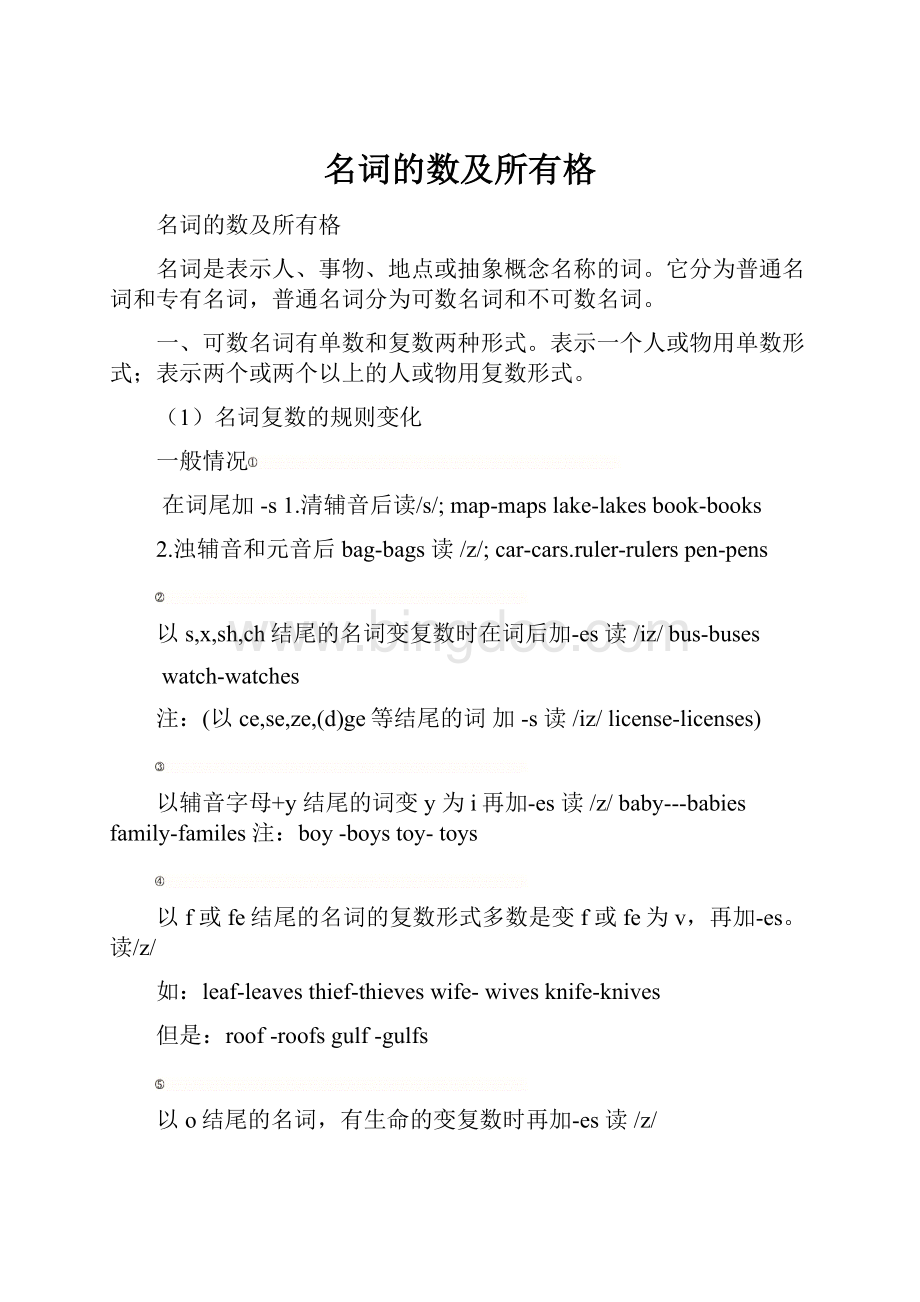名词的数及所有格.docx
《名词的数及所有格.docx》由会员分享,可在线阅读,更多相关《名词的数及所有格.docx(56页珍藏版)》请在冰点文库上搜索。

名词的数及所有格
名词的数及所有格
名词是表示人、事物、地点或抽象概念名称的词。
它分为普通名词和专有名词,普通名词分为可数名词和不可数名词。
一、可数名词有单数和复数两种形式。
表示一个人或物用单数形式;表示两个或两个以上的人或物用复数形式。
(1)名词复数的规则变化
一般情况
在词尾加-s1.清辅音后读/s/;map-mapslake-lakesbook-books
2.浊辅音和元音后bag-bags读/z/;car-cars.ruler-rulerspen-pens
以s,x,sh,ch结尾的名词变复数时在词后加-es读/iz/bus-buses
watch-watches
注:
(以ce,se,ze,(d)ge等结尾的词加-s读/iz/license-licenses)
以辅音字母+y结尾的词变y为i再加-es读/z/baby---babiesfamily-familes注:
boy-boystoy-toys
以f或fe结尾的名词的复数形式多数是变f或fe为v,再加-es。
读/z/
如:
leaf-leavesthief-thieveswife-wivesknife-knives
但是:
roof-roofsgulf-gulfs
以o结尾的名词,有生命的变复数时再加-es读/z/
如:
Negro-Negroes黑人hero-heroes英雄tomato-tomatoes西红柿potato-potatoes马铃蓍(口诀:
黑人英雄吃西红柿和马铃蓍)
无生命的变复数时加-s读/z/如:
photo-photosradio-radios
(2)名词复数的不规则变化:
改变单数名词中的元音字母,或其他形式。
如
child---childrenfoot---feettooth---teethgoose-geese
mouse---miceman---menwoman---women
国人变复数:
中日不变,英法变,其它加-s
OneChinese-twoChineseoneJapanese-twoJapanese
AnEnglishman-threeEnglishmenaFrenchman-twoFrenchmen
AnAmerican-twoAmericansaGerman-twoGermans,此外Russian,African,Asian,Australian,Canadian,Italian,European等变复数时都是直接在词尾加-s.
复合名词的复数形式.
.名词加名词构成的复合名词,将第二个名词变为复数.如
appletree–appletreesshoeshop–shoeshopsletterbox-letter-boxes
girlstudent–girlstudentsboystudent–boy-students
注意:
与man和woman构成的合成词,变复数时要把这两个词都变成复数.
manteacher–menteacherswomandoctor–womendoctors
.sport和其他名词构成词组时,习惯上用复数形式sports.
如:
asportshatsportsnewssportsshoes
特别的复数形式
.单复同形如:
deer,sheep,fish,Chinese,Japanese
li,jin,yuan,twoli,threemao,fourjin
但除人民币元、角、分外,美元、英镑、法郎等都有复数形式。
如:
adollar,twodollars;ameter,twometers
.集体名词,以单数形式出现,但实为复数。
如:
peoplepolicecattle等本身就是复数,不能说apeople,apolice,acattle,但可以说
aperson,apoliceman,aheadofcattle,theEnglish,theBritish,theFrench,theChinese,theJapanese,theSwiss等名词,表示国民总称时,作复数用。
如:
TheChineseareindustriesandbrave.中国人民是勤劳勇敢的。
.以s结尾,仍为单数的名词,如:
a.maths,politics,physics等学科名词,为不可数名词,是单数。
b.news是不可数名词。
c.theUnitedStates,theUnitedNations应视为单数。
TheUnitedNationswasorganizedin1945.联合国是1945年组建起来的。
d.以复数形式出现的书名,剧名,报纸,杂志名,也可视为单数。
"TheArabianNights"isaveryinterestingstory-book.
<<一千零一夜>>是一本非常有趣的故事书。
.表示由两部分构成的东西,只用复数形式如:
glasses(眼镜)trousers裤子clothes衣服gloves手套stockings长筒袜
若表达具体数目,要借助数量词pair(对,双);suit(套);apairofglasses;twopairsoftrousers
.另外还有一些名词,其复数形式有时可表示特别意思,如:
goods货物,waters水域,fishes(各种)鱼
二、不可数名词的数
不可数名词一般没有复数形式,它包括抽象名词,物质名词。
如:
healthadvicemilkwaterEnglishmoneynewsweatherhomework
airinformationricetrafficluckpapertrouble等词常用作不可数名词,因此没有复数形式,其谓语动词须用单数形式。
注意:
当water意为“海水,江水”,paper意为“报纸,试卷”时可有复数形式。
特别提示:
不可数名词还可以量化,但须用表示量化单位的词来修饰。
如:
apieceofnews/paper/work/bread/meat
abottleofmilk/water
threebowlsofricetencupsoftea
名词的格
1.表示有生命的名词的名词所有格
(1)一般在词尾加“'s”
如mymother’sbirthdayJim’spen
(2)以s结尾的名词所有格,一般只在名词右上加“’”。
如theteachers’officetheworkers’clubboys’100-meterrace
(3)如果两个人共同拥有一样东西,刚只在最后一个名词后加上“'s”;如果是名自拥有,两个名词后面都要加上“'s”。
如:
lilyandlucy’sroom(共同拥有)
Lily’sandlucy’srooms(各自拥有)
特别提示:
若名词所有格后所修饰的词表示“家,店铺,办公室”等地点名词,地点名词通常可以省略。
如:
atMr.White’s在怀特先生家
Atthedoctor’s在诊所在atthetailor’s在裁缝店
2.表示无生命的名词的所有格
(1)通常采用“of+名词”结构来表示无生命东西的名词所有关系,放在被修饰名词的后面。
如thedoorofthehousethecoverofthebook
Thegateoftheschoolthenameofthefilm
(2)有些表示时间、距离、国家、城市、团体、机构等无生命东西的名词,也可以加上“'s”来构成所有格。
复数名词如果以s 结尾,在s的在上角加“'”即可。
如:
today’snewspapertenhours’work
(3)有几种情况用to来表达所有格
Thekeytothedoor门口的钥匙theanswertothequestion问题的答案thetickettotheconcert音乐会的门票
3.双重所有格
双重所有格是将of所有格和“'s”所有格结合在一起表示所有关系。
如:
Afriendofmysister’siscomingtonight.今晚我姐姐的一个朋友要来
Twosonsofmybrother’sarestudents我哥哥的两个儿子是学生。
注意:
aphotoofKate’s凯特的一张相片(照片有很多张,这只是其中一张,照片上拍的人不一定是凯特)aphotoofKate一张凯特的照片(照片上拍的人是凯特)
三、专有名词
专用名词是表示具体的人、事物、地点或机构等专有名称的词汇。
专有名词的第一个字母要大写,专用名词前一般不用冠词,但由普通名词构成的专有名词除外。
如:
SundayNewYorkEnglandWestlaketheGreatWall
1、Iwantthree whitepaper.
A、pieces B、pieceof C、piecesof
2、Doyouwanttodrinkmuch ?
A、amilk B、milk C、milks
3、Thisis room.It’sverybig.
A、LilyandLucy’s B、Lily’sandLucy’s C、Lily’sandLucy4、Wevisited houseyesterday.
A、Tom B、Toms C、Tom’s
5、Doyouwantsome forsupper?
A、apotato B、potatoes C、potatos
6、Inautumn,youcanseealotof ontheground.
A、leaf B、leafs C、leaves
7、Mysisterhastwo .Oneisold,theotherisnew.
A、awatch B、watchs C、watches
8、Bestwishestoyoufor Day!
A、Teacher’s B、Teachers’ C、Teacher
9、Manychildrenliketogotothe PalaceonSunday.
A、Children B、Children’s C、Childrens’
10、TheycomefromJapan.They’re .
A、Japanese B.JapanesesC.Japans
11.theycomefromdifferent
A.countryB.countriesC.acountryD.countrys
12.Howmanydoyouseeinthepicture?
A.tomatosB.tomatoesC.tomatoD.thetomato
13.Theyare.
A.womanteachersB.womenteachers
C.womanteacherD.womanteacher
14.Wouldyoulike,please?
A.twoglassofwaterB.twoglassesofwater
C.twoglassofwatersD.twoglassesofwaters
15.Mostoflivein.
AGermans,GermanB.German,Germen
C.Germen,GermanyD.Germans,Germany
16.Therearesomeinthese.
A.knifes,pencil–boxesB.knives,pencils-box
C.knives,pencil–boxD.knives,pencils-boxes
17.PeopleinAmericaeatmuch.
A.coffeeB.onionsC.beefD.icedwater
18.Tokeephealthy,weshouldeatmorevegetablesandless
.
A.meatB.foodC.wineD.drink
19.Canyouimaginewhatlifewillbelikeintime?
A.20years’B.20year’sC.2-years’D.20-years
20.Whatkindofdoyoulike?
Ilikecomedies
A.booksB.sportsC.moviesD.music
21.What’syourfavoriteChinesetraditionalfestival?
It’s.
A.AprilFool’sDayB.Father’sDay
C.ChristmasDayD.SpringFestival
22.InBritainareallpaintedred.
A.letterboxesB.lettersboxesC.letterboxD.lettersbox
23.IhavereadsportsnewsabouttheF1racetoday.
A.twoB.piecesC.twopieceDtwopiecesof
24.Wherearethebags?
A.childrens’B.children’sC.childrenofD.ofchildren
25.Theroomis.
A.LilyandlucyB.LilyandLucy’s
C.Lily’sandLucy’sD.Lily’sandlucy
26.IsitbetweenLilyandLucy,thatistosaymyseatisbetween
A.LilyandlucyB.LilyandLucy’s
C.Lily’sandLucy’sD.Lily’sandlucy
27.Iknowtwoonyourbasketballgame.
A.womanplayerB.womanplayers
C.womenplayersD.womenplayer
28.Whereisthekeythedoor?
A.ofB.onC.toD.in
29.Astudentofiscomingtoseeme
A.meB.myC.mineD.I
30.Apersonhastwo.
A.footB.footsC.feetD.feets
2.填入所给名词的正确形式.
1.Ihavetwo(knife)
2.Therearemany(box)here.
3.Therearemanyontheroad.
4.Afew(boy)aredrawingonthewall.
5.The(child)areplayingfootballnow.
6.Canyouhelpmebuysome(tomato)?
7.Wouldyouliketofeedthe(deer)?
Theyarelovely.
8.The(mandoctor)trytheirbesttosavethegirl.
9.(Today)newspaperisveryuseful.
10.Alotof(toy)areusefulforchildren.
11.Oneofour(student)haslonghair.
12.Anyofyour(idea)wouldbewelcome.
13.IhavereadoneofLuXun’s(book)
14.Couldyougivemesome(toothbrush)
15.Thelittlegirlhas4(tooth)
16.Therearemorethanfifty(piano)inLaibin.
17.Doyouknowthetwo(Canada)
18.(leaf)ofthetreesbegintoturnyellowinautumn.
19.Ihavealotof(homework)todo.
20.Canyougivemesome(advice)onlearningEnglish?
一般现在时
定义:
一般现在时表示现在经常反复发生的动作、存在的状态或习惯性的动作的时态。
一般现在时的结构:
1.be动词所构成的句子
肯定句:
I+am+其它
You\we\they+are+其它
He\she\it+is+其它
否定句:
I+am+not+其它
You\we\they+are+not+其它
He\she\it+is+not+其它
一般疑问句:
are+you\we\they+其它…?
Yes,Iam.\No,Iamnot.
Is+he\she\it+其它…?
Yes,heis.\No,heisn’t.
特殊疑问句:
疑问词+be(are\is\am)+主语+其它
2.therebe句型结构:
肯定句:
thereis+单数名词\不可数名词
thereare+可数名词的复数
否定句:
thereis\are+not+其它
一般疑问句:
is\are+there+其它…?
Yes,thereis\are.No,thereisn’t\aren’t.
特殊疑问句:
疑问词+is\are+there+其它…?
3.情态动词的句子:
肯定句:
主语+can\may\must+其它(情态动词无人称上的变化)
如:
Icanswim.Shecanswim.Theycanswim.Wecanswim.
否定句:
主语+can\may\must+not+其它(can’t=cannot)
Ican’tswim.
一般疑问句:
can\may\must+主语+萁它…?
Canyouswim?
Yes,Ican.\No,Ican’t.
特殊疑问句:
疑问词+can\may\must+主语+萁它…?
Whatcanyoudo?
4.谓语动词是行为动词的句子:
(1)当主语是第一人称(I\we),第二人称(you),第三人称复数(they)时
肯定句:
I\we\you\they+行为动词的原形+其它.
如:
I\we\you\theylikeapples.
否定句:
I\we\you\they+don’t+行为动词的原形+其它.
I\we\you\theydon’tlikeapples.
一般疑问句:
Do+I\we\you\they+行为动词的原形+其它…?
DoI\we\you\theylikeapples?
Yes,Ido.\No,Idon’t.
特殊疑问句:
疑问词+do+I\we\you\they+行为动词的原形+其它…?
Whatdoyoulike?
(2)当主语是第三人称单数时(he\she\it)时
肯定句:
He\she\it+行为动词的三单形式+其它.
Helikesapples.
否定句:
he\she\it+doesnot(doesn’t)+行为动词的原形+其它
Hedoesn’tlikeapples.
一般疑问句:
Does+he\she\it+行为动词的原形+其它?
Doeshelikeapples?
Yes,hedoes.\No,hedoesn’t.
特殊疑问句:
疑问词+does+he\she\it+行为动词的原形+其它?
Whatdoeshelike?
注意:
行为动词的三单变化规律:
多数动词直接在动词后+s如:
play-playslike-likesask-asks
以字母s,x,sh,ch,o结尾的动词,在词尾加-es
如:
watch–watcheswish-wishesdo-doesgo-goespass-passes
以辅音字母+y结尾的词变y为i再加-es
try-triesstudy-studiesfly-fliescarry-carries
不规则变化:
be-is\arehave-has
读音规则:
在\t\\p\\k\等清辅音后读\s\;在\s\,\z\等后读\IZ\
在浊辅音及元音后读\z\.
一般现在时的用法:
1) 经常性或习惯性的动作,常与表示频度的时间状语连用。
通常与every…,sometimes,usually,